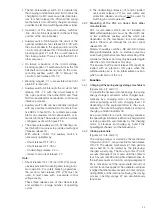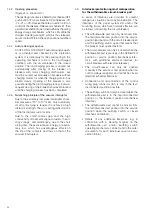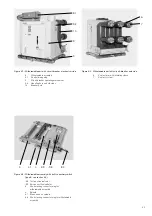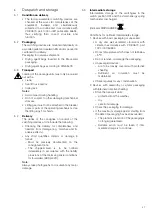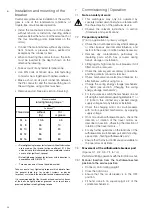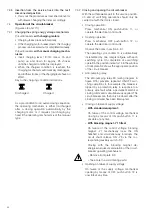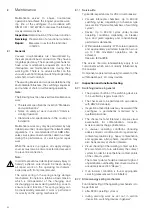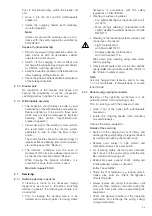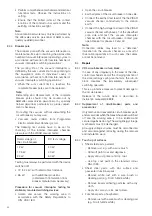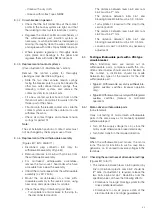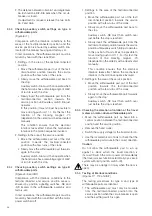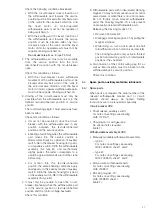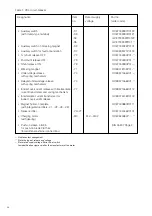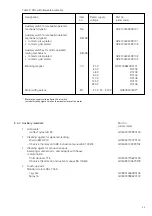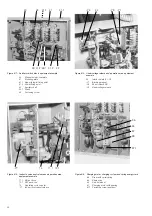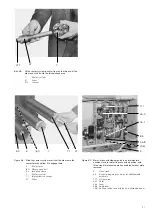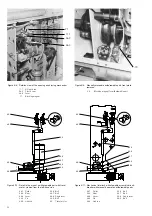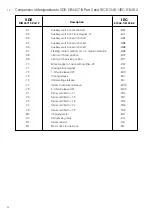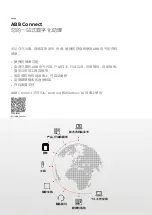
46
2. The distance between roller 46.1 and angle lever
46.8 should be
0.2-0.5 mm
when the circuit-
breaker is closed.
If adjustment is required, release the two bolts
46.7 and 46.6.
8.5.3
Checking auxiliary switch settings on type A
withdrawable parts
(Figure 8/7 )
Compliance with the interlock conditions in the
areas of the test/disconnected position and the
service position is ensured by auxiliary switch -S6,
located in the breaker housing and factory-set.
In test operations, the withdrawable part must be
moved by hand with the crank fitted.
1. Settings in the area of the test/disconnected
position
• Move the withdrawable part out of the test/
disconnected position towards the service
position with a few turns of the crank.
• Slowly move the withdrawable part back to
the stop.
Auxiliary switch -S6 must then operate when
the hand crank has a remaining angle of
≥
60
o
of turn to reach the stop.
• Slowly insert the withdrawable part from the
test/disconnected position towards the
service position until auxiliary switch -S6 just
operates.
In this position, it must still just be possible to
move closing push rod 11.1. For this test, the
function of the blocking magnet -Y0
(dependent on the order) must be deactivated
manually.
This condition ensures that the electrical
interlock takes effect before the mechanical
interlock in the motion sequence involved.
2. Settings in the area of the service position
• Move the withdrawable part out of the limit
position towards the test/disconnected
position with a few turns of the crank.
• Slowly move the withdrawable part forwards
again to the stop:
Auxiliary switch -S6 must then operate when
the hand crank has a remaining angle of
≥
60
o
of turn to reach the stop.
8.5.4
Checking auxiliary switch settings on type B
withdrawable parts
(Figures 4/3 and 8/7)
Compliance with the interlock conditions in the
test/disconnected and service position areas is
ensured by position signalling switches -S8 and
-S9 located in the withdrawable assembly and
factory-set.
In test operations, the withdrawable part must be
moved by hand with the crank fitted with the motor
power switched off.
1. Settings in the area of the test/disconnected
position
• Move the withdrawable part out of the test/
disconnected position towards the service
position with a few turns of the crank.
• Slowly move the withdrawable part back to
the stop.
Auxiliary switch -S8 must then switch over
just before the stop is reached.
• Slowly insert the withdrawable part from the
test/disconnected position towards the service
position until auxiliary switch -S8 just operates.
In this position, it must still just be possible to
move closing push rod 11.1. For this test, the
function of the blocking magnet -Y0
(dependent on the order) must be deactivated
manually.
This condition ensures that the electrical
interlock takes effect before the mechanical
interlock in the motion sequence involved.
2. Settings in the area of the service position
• Move the withdrawable part out of the limit
position towards the test/disconnected
position with a few turns of the crank.
• Slowly move the withdrawable part forwards
again to the stop:
Auxiliary switch -S9 must then switch over
just before the stop is reached.
8.5.5
Checking the direction of rotation of the travel
motors on motor-driven withdrawable parts
• Move the withdrawable part by hand into a
central position between the test/disconnected
position and the service position.
• Remove the hand crank.
• Switch the supply voltage for the travel motor on.
• Use the local electrical controls to check that the
withdrawable part moves in the correct direction.
Caution:
Do not allow the withdrawable part to run up
against a block when the travel direction is
incorrect! Switch the motor power off immediately
(the travel process functions electrically by a seal-in
system with limit position switch-off).
There may be a danger of injury when the door is
open!
8.5.6
Testing of interlock conditions
(Figures 7/1, 7/2 and 8/7)
The testing procedures for type A and type B
withdrawable parts are identical.
1. The withdrawable part must only be movable
from the test/disconnected position into the
service position when the circuit-breaker is open
and the earthing switch is open.


